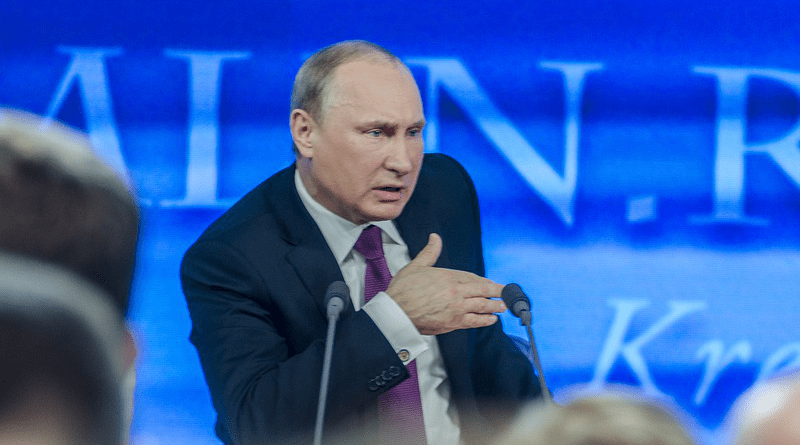Is Putin Close To Using Nukes In Ukraine? – OpEd
The destruction of the crucial Kerch Bridge on the Sea of Azov – a Russian red line – as well as recent attacks on the North Stream 1 and 2 pipelines at the bottom of the North Sea, show that Washington and Moscow are more willing than ever to exert pressure on one another and alter the nature of the battlefield.
What other destructive weapons would Russia and the US employ before resorting to nuclear weapons? It would be simple to predict how long it will be before nuclear weapons are used and how much nuclear damage will be done once other destructive weapons have lost their effectiveness.
The current battlefield conditions suggest that the time has come for Moscow and Washington to think and decide because how they continue the war in Ukraine will determine whether they lose or win the potential nuclear war. Although Biden regards Putin as a “rational actor,” he believes the risk of nuclear Armageddon is at its highest since the 1962 Cuban Missile Crisis. As Russia approaches defeat, is it likely that insanity replaces Putin’s rationality and the risk of nuclear war increases?
After the Russian army failed to achieve its predetermined goal to completely invade Ukraine in a few weeks, Kremlin declared that it would use nuclear weapons “if Russia’s very existence was threatened”. Even the deputy chairman of the Russian Security Council, Dmitry Medvedev, stated that Moscow will use any weapon required to defend areas that should join Russia. He claimed that Moscow has the right to protect its borders with any weapon in its arsenal, including strategic nuclear weapons.
A few months ago, during a visit to the Office of the US Director of National Intelligence, US President Joe Biden emphasized that the US intelligence services are “better than” their Russian counterparts and that Putin is “sitting on top of an economy that has nuclear weapons and oil wells and nothing else”. “He knows he’s in real trouble, which makes him even more dangerous” he added. In a guest essay for The New York Times President Biden wrote: “any use of nuclear weapons in this conflict on any scale would be completely unacceptable to us as well as the rest of the world and would entail severe consequences” for Russia.
Furthermore, during his mysterious trip to Washington, Ben Wallace, the UK Secretary of State for Defense, described his talks with his American counterpart and senior White House officials as “beyond belief,” indicating that extremely sensitive and critical issues such as the withdrawal of Russian military forces and Putin’s possible use of unconventional warfare were discussed.
When Putin and Biden, as the leaders of two nuclear powers, threaten to utilize nuclear weapons, it seems likely that they are preparing the world’s population for the potential of nuclear war. Seventy-seven years after the first-ever nuclear explosions in Hiroshima and Nagasaki, the likelihood of this lethal weapon being used again has skyrocketed. The military and intelligence agencies are also conducting computer simulations at nuclear facilities. These powers keep iterating that they have a variety of devastating methods for destroying each other, which is not a bluff.
To ensure its supremacy, the US used unconventional tactical warfare in Japan, Vietnam, Afghanistan, and Iraq. Along the same line, if push comes to shove and Russia loses more grounds, particularly Donbas and Crimea, Putin will use nuclear weapons to save himself and Russia. If Putin decides to use nuclear weapons, the West must accept defeat or risk a full-scale nuclear war when faced with “the only option of countermeasure.”
In the case of a nuclear confrontation between the two military superpowers, the West will have to decide whether victory against Russia is worth losing Washington, London, Paris, and Berlin. According to Sky News, Russia is capable of destroying significant cities in the West, such as London and Washington. Once fired, Russia’s nukes take around 20 minutes to hit London. Approximately 4,477 nuclear weapons are in Russia’s arsenal, according to estimates from Western intelligence agencies, notably the Bulletin of Atomic Scientists (March 2022), whereas 5,943 nuclear warheads are in the hands of the Western coalition supporting Ukraine (with the US having 5428, the UK 225, and France 290 warheads). Additionally, on the TNT scale, each nuclear bomb has an explosive force of 300 to 800 kilotons.
To prepare the minds of the citizens of Western countries, movies have been made that demonstrate how a nuclear weapon equivalent to 300 kilotons of TNT can demolish Washington, London, or Paris. By making threats like this, Russia hopes to influence analysts and decision-makers to concentrate on the threat rather than assisting Ukraine.
The West seeks victory or conditions that will force Putin to sit at the negotiating table and compensate for the damage done to Ukraine. NATO began its two-week-long military exercises over the skies of northwest Europe on October 17 in response to Russian naval mines and its 58 advanced nuclear submarines to ensure nuclear deterrence policy against Russia. This exercise included sixty aircraft from 14 countries, as well as underwater drones.
Additionally, on October 19, General Michael Kurilla, the commander of CENTCOM, paid a visit to the USS West Virginia, a nuclear-powered ballistic missile submarine operating in the Red Sea, as NATO conducted nuclear exercises. This visit, which took place at an undisclosed location at sea level, is a rare move that emphasizes the importance of nuclear deterrence policy in a time of tension with Russia and China.
Nonetheless, a new cold war has begun, one that is fundamentally different from the Soviet-era cold war. Political threats replaced military threats to maintain peace at the time, whereas in the new cold war, which is actually a hot war, military threats have replaced political threats and nuclear war is not improbable.

